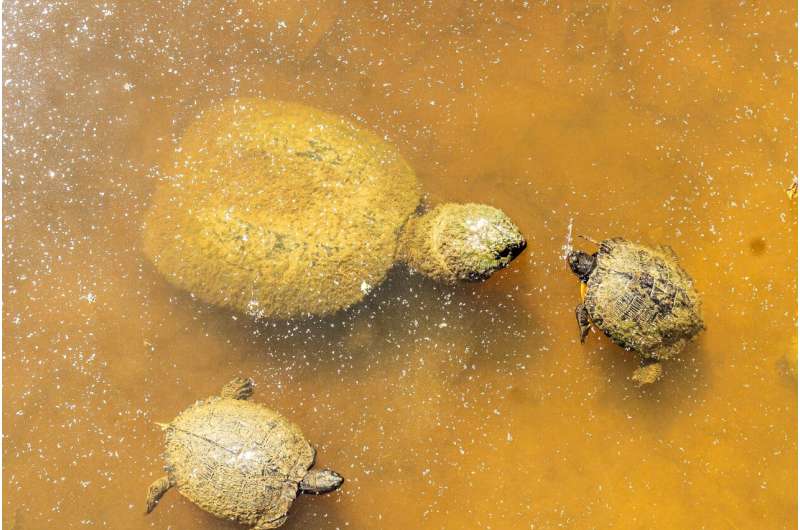This article has been reviewed according to Science X's editorial process and policies. Editors have highlighted the following attributes while ensuring the content's credibility:
fact-checked
reputable news agency
proofread
Kansas is bringing the alligator snapping turtle back to its waters after 33-year absence

While the alligator snapping turtle might look like a giant beetle made from volcanic rock, these unique creatures are native to Kansas' rivers—and they're about to make a triumphant homecoming.
Alligator snapping turtles are the bigger, spikier, beakier cousins of the common snapping turtles you've probably seen before. They're vital to Kansas' aquatic ecosystems, hoovering up dead fish and debris from riverbeds and acting as a "cleaning crew" for waterways.
But experts haven't seen one in the wild in Kansas for 33 years. Dam construction, harm from fishing equipment and hunting by humans are among the reasons the species disappeared.
Now, there's a plan to get these unique turtles back into Kansas' waters. Starting this fall, Kansas wildlife officials and Missouri State University researchers will release tagged alligator snapping turtles—bred in captivity in Oklahoma—into the Neosho River in eastern Kansas. It will be their first attempt to reintroduce the species in the state.
Here's how you can help these turtles thrive, and what to do if you spot one in person.
Are alligator snapping turtles dangerous?
Alligator snapping turtles almost never interact with humans. They like to live in deep water around fixtures like sunken trees, and they rarely come onto land. Their diet mostly consists of dead fish and other small animals.
While these turtles have enormous chomping power, they won't use it on you as long as you don't bother them.
"There are no records of a turtle unintentionally biting a human," writes the Kansas Department of Wildlife and Parks. "All bites are the result of humans attempting to handle the turtle."
The department notes that unattended fishing lines, like trotlines, setlines and floatlines, can ensnare turtles and are a leading cause of harm and death. If you get one caught in your fishing setup, cut the line immediately to set the turtle free.
What should I do if I see an alligator snapping turtle?
Alligator snapping turtle sightings are unheard of in Kansas in recent decades, and they will continue to be rare after the reintroduction program begins. However, there's a slim chance you may spot one while out on the river.
Alligator snapping turtles differ from their common snapping turtle cousins in a few ways. First, the adults have rough, spiked shells and larger front "beaks" than common snappers. You can also tell an alligator snapping turtle by the extra row of scales on the sides of its shell.
Common snappers have white dots on their undersides, while alligator snappers don't. However, it's best to keep a respectful distance and avoid handling any snapping turtle you see.
Instead, experts urge anglers and other nature lovers to snap a photo of any suspected alligator snapping turtle you see—including ones with identifying tags. Email the photo to rare.species@ks.gov to help the state track the turtles' spread through Kansas' waterways.
2024 The Kansas City Star. Distributed by Tribune Content Agency, LLC.



















